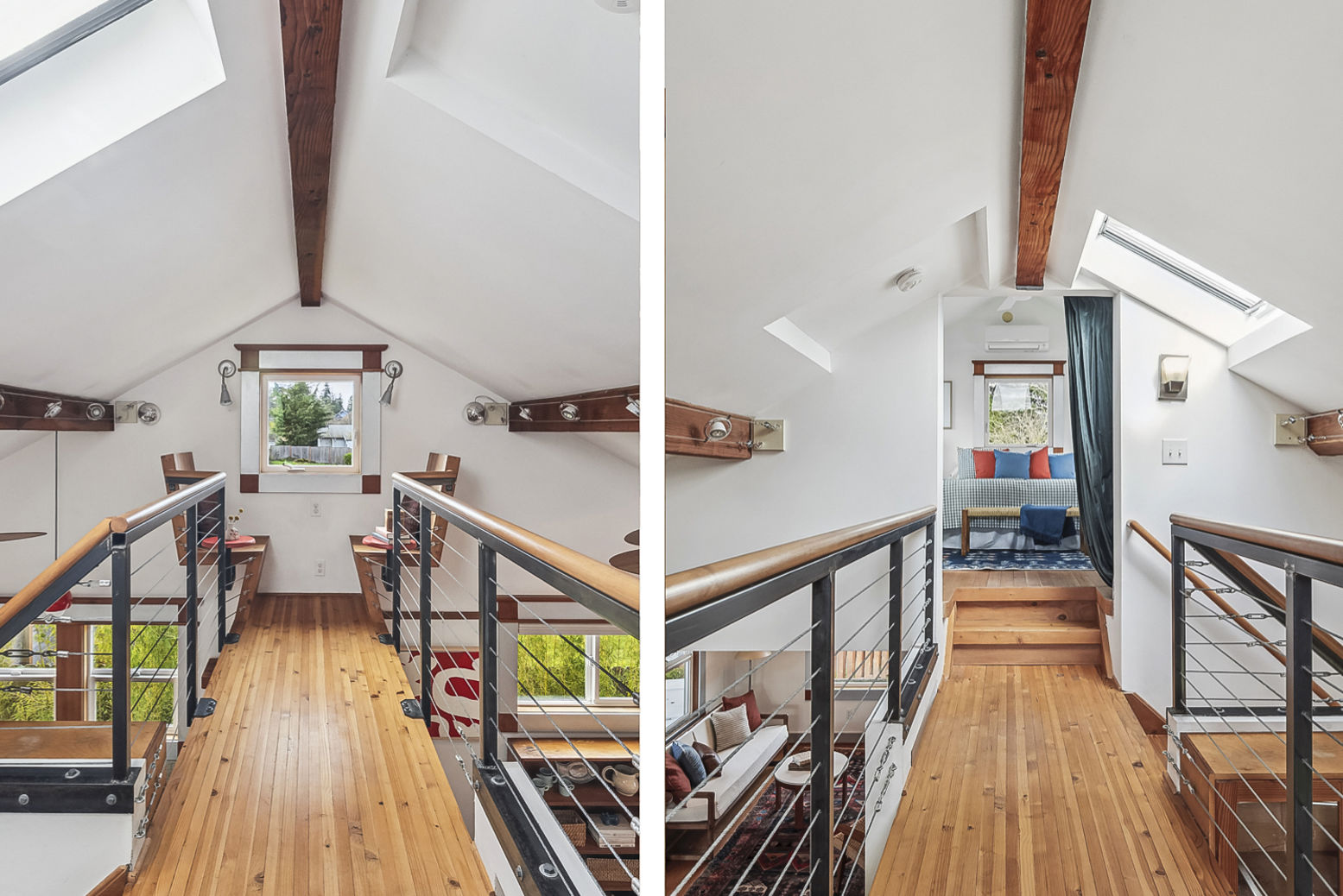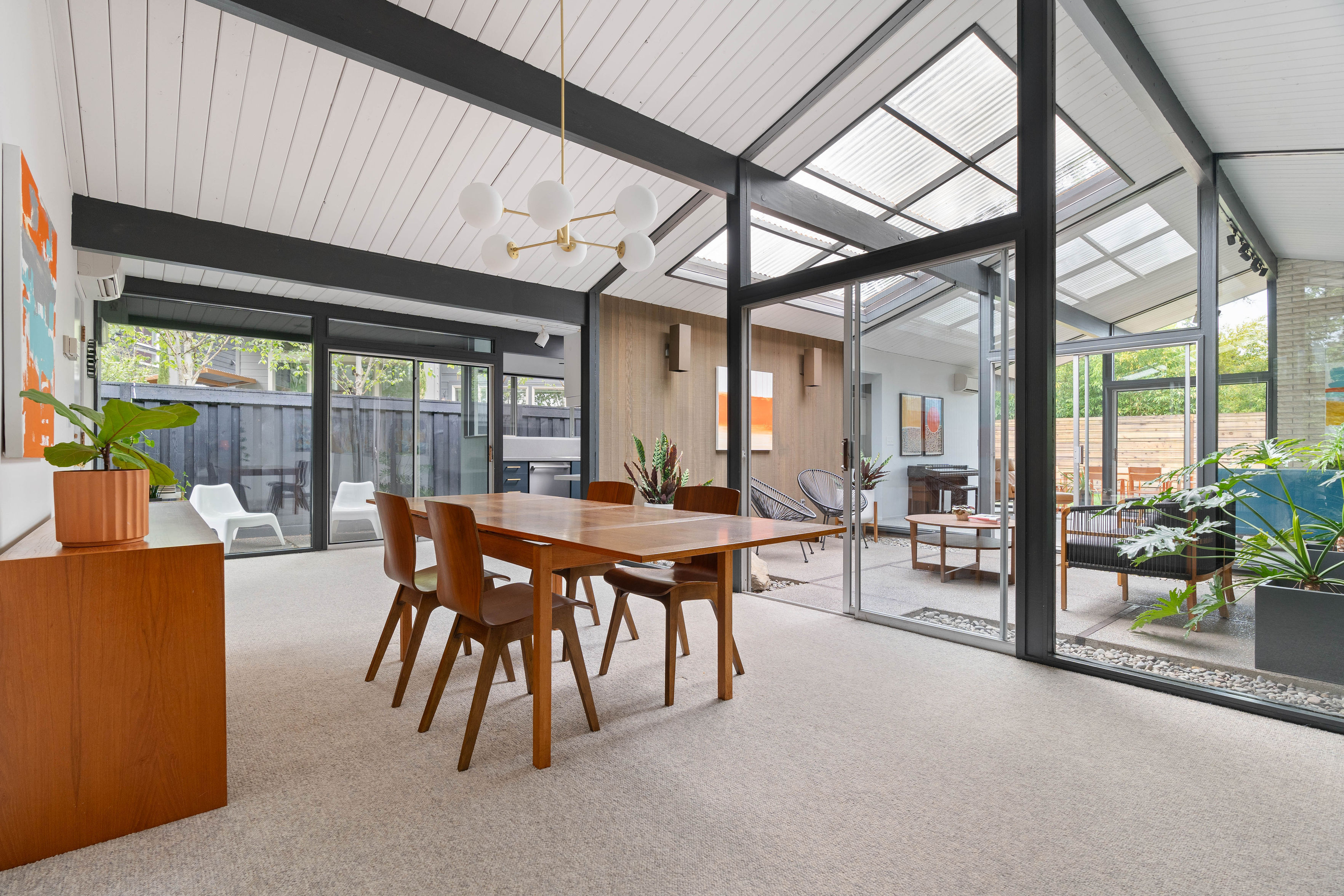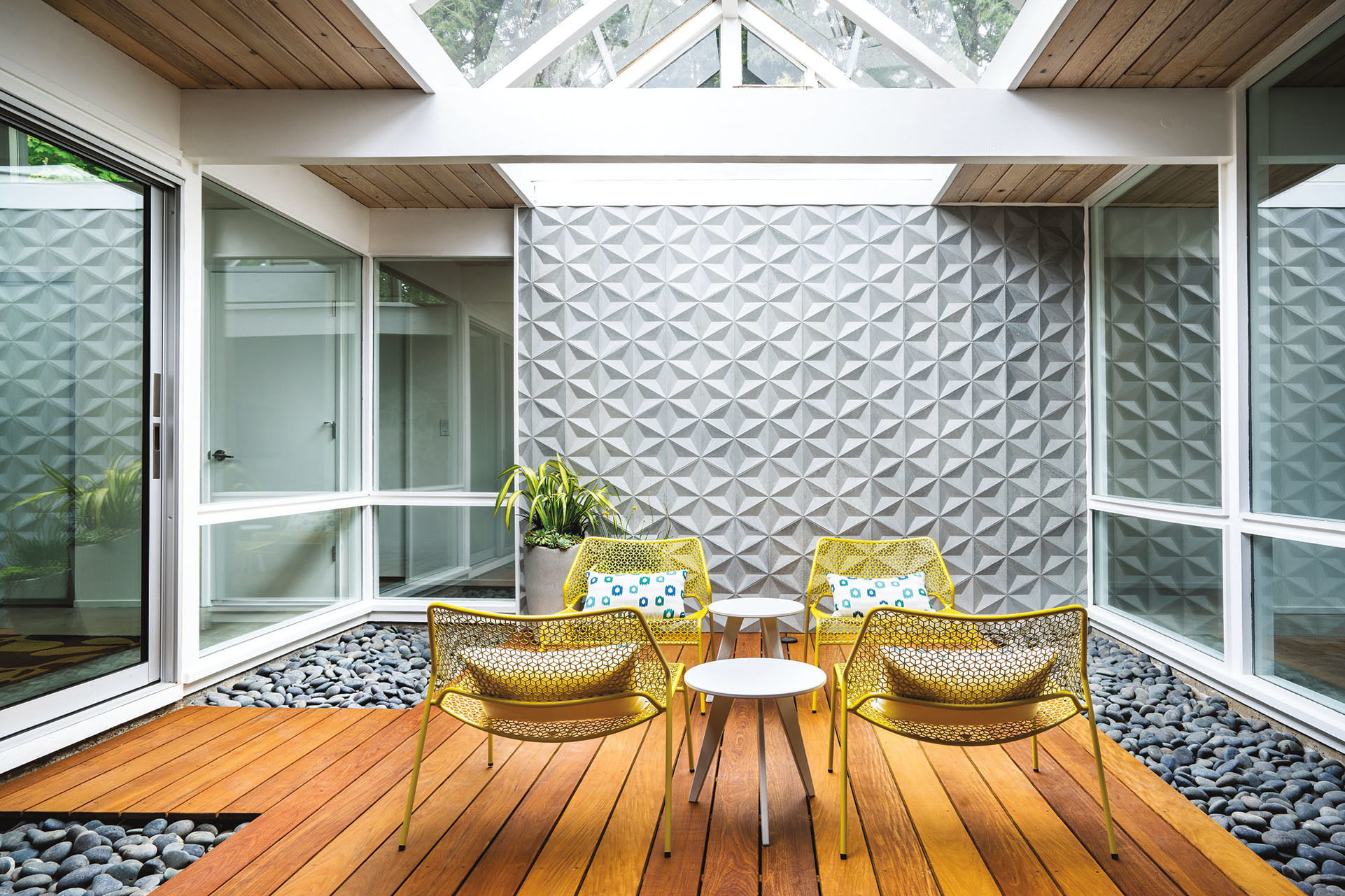
Three Drool-Worthy Portland Remodels
Rethinking the Rummer
An updated Rummer house repurposes the midcentury-modern atrium
Midcentury-modern houses by builder Robert Rummer, like the famed Joseph Eichler homes in California they were patterned after, are highly coveted today. Abundant natural light and open plans make them feel as ahead of their time as they are stylistically retro-chic. But in 2019, they can also feel physically worn out and awkwardly designed.
The three-bedroom, 1,741-square-foot Rummer house from 1971 in Beaverton’s Highland neighborhood had a lot to offer: vaulted cedar ceilings with glass transom windows on the walls, an expansive backyard seen through more floor-to-ceiling glass, and an atrium that filled the house with illumination. Says interior designer Garrison Hullinger: “I remember thinking, ‘We found one. It’s a challenge, but we found one.’”
The private side of the house seemed awkwardly configured: you could see into the bathroom from the front door of the house. And the location of the atrium, between the entry and great room, was baffling. With an ambiguity of function common to Rummers, it had been wasted as an extended foyer, an out-of-control philodendron taking up nearly half the space.
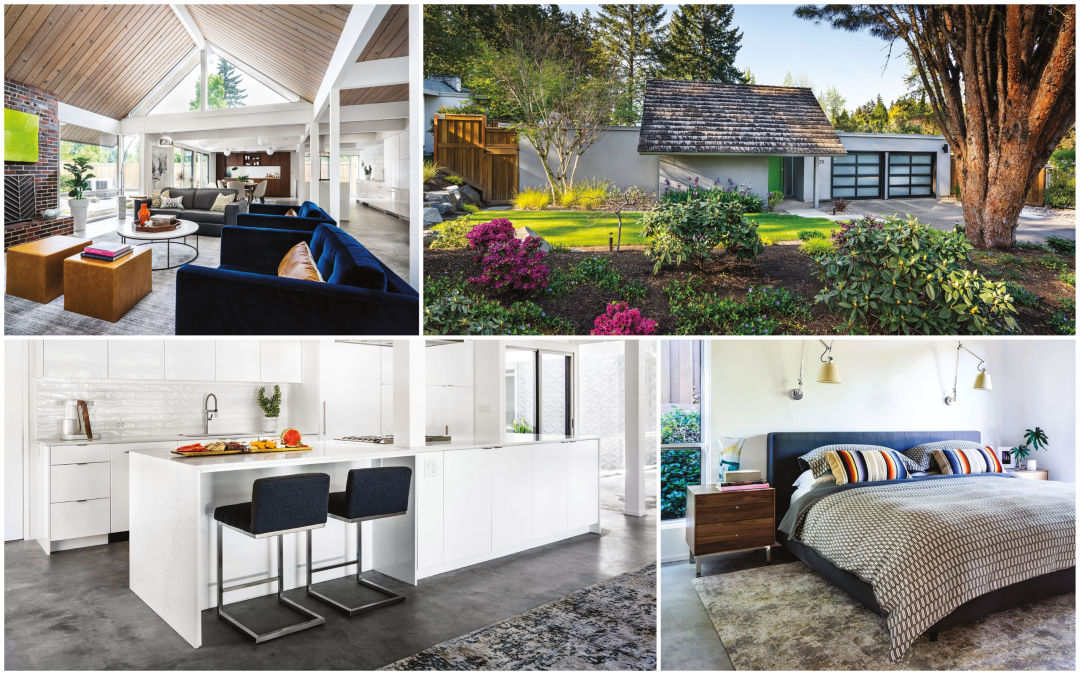
A partial pitched roof creates a vaulted ceiling and atrium—and a lot more light—in this revamped Rummer.
Hullinger’s team, led by interior designer Nikki Maeda, made the atrium feel more fully like the outdoors, adding a naturally stained teak deck and even placing clusters of river rocks in the corners, as if the deck were a floating dock. Next to a cluster of garden chairs, a wall of decorative patterned concrete tiles (by artist Daniel Ogassian for Ann Sacks) draws the eye. Instead of a pass-through space, the glass-roofed atrium now acts more like an enclosed front yard.
The hallway coat closet, bathroom, and master bedroom were then reconfigured to add privacy and allow a walk-in closet for the master, but only after some brief soul-searching. “For a moment we said to ourselves, ‘Can we do this to a Rummer?’ But there’s got to be some practicality,” Hullinger says.
Adjacent to the vaulted living room, the low-ceilinged kitchen was too dark. Hullinger’s team refinished the globe-shaped pendant lights and relocated them to the dining room to create a more defined dining area. Simple task lighting was then added to the kitchen itself, leaving the cedar ceiling untouched. White cabinetry in a high-gloss finish spreads the light and also hides most of the kitchen appliances from view, while a thin strip of white quartz countertop—continuing as backsplash for the walnut hutch built into the adjacent dining-room wall—is one of the many small details that now make the house sing.
“Everything just looks cleaner,” Hullinger says. “The big challenge to us was taking all the random changes people had made [over the years] and stitching the place together again.”
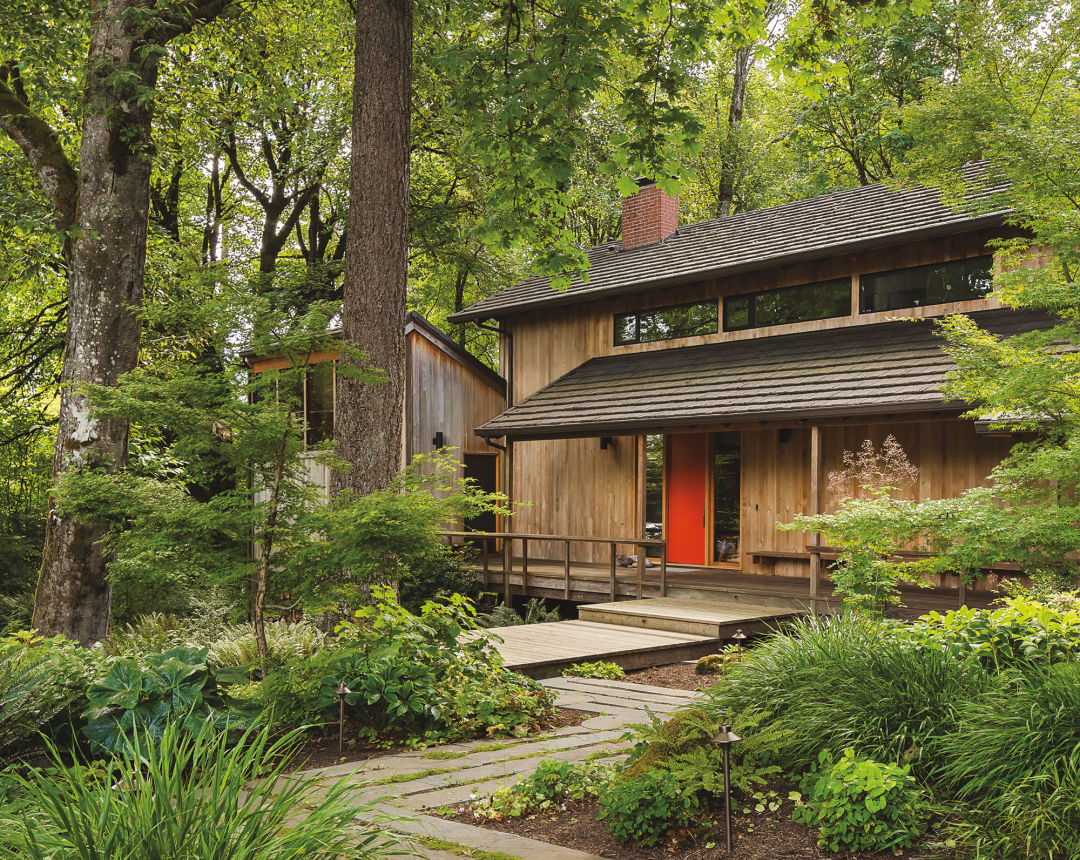
Image: Chuck Collier Schmidt
Hidden Fortress
A cedar-clad John Storrs classic comes out of the forest
When they purchased a 1959 house in Portland’s West Hills by celebrated local midcentury-modern architect John Storrs six years ago, husband-and-wife Jason Nims and Maria Bezaitis were pleasantly surprised to learn a power hose could be transformative.
Nestled in a wooded setting off Skyline Boulevard, with 13 mature trees in the front yard alone and overlooking six acres of conservation land, the 3,200-square-foot house was almost hidden when they purchased it. But that actually did the home’s unfinished white cedar siding a favor. Layers of grime and old stain had turned the wood “the color of Coke,” Nims recalls. A pressure wash revealed not the usual gray-toned aged cedar, but something rarer: wood with an exquisite golden patina. “The oil came out of the wood again, and all you could smell was cedar,” says Nims. “It was amazing.”
The redesign by Paul McKean Architecture and interior designer Jennifer Fowler left most of Storrs’s original home intact, including the long, covered front porch. Inside, though, the house was surprisingly dark—due to not only the extensive wood paneling, but also a lack of windows facing the street. “With that midcentury crew it’s often about inside-outside. That wasn’t the case here,” McKean says. It was as if Storrs wanted the occupants to forget the outside world and focus solely on the woods in back—or, better yet, to focus inward: a wooded and wood-festooned oasis. “That’s what was really precious: the craft that went into it all.”
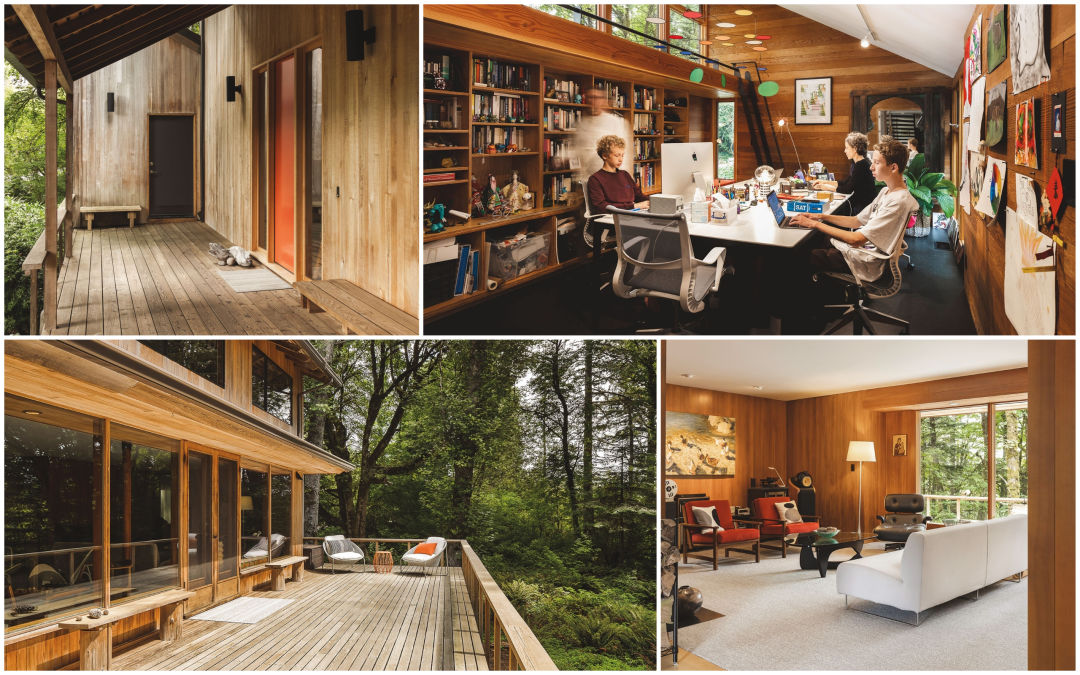
The renovated Nims-Bezaitis residence now opens itself up to the surrounding forest, with a modest kitchen expansion and widened doorways giving the home an even more open feel. Northwest midcentury-modern homes specialize in creating outdoor spaces, as the Nims-Bazaitis residence does in both front and, thanks to a Paul McKean-designed renovation, a large deck in back.
Image: Chuck Collier Schmidt
To better distribute the light, McKean’s renovation discreetly added glass to the front of the house (strips of glass surrounding the doorway and one other small band), and inside, larger doorways were created between the foyer, living room, and kitchen. The design also modestly expanded the kitchen’s footprint in the back of the house. But the wood paneling? Sacrosanct. This was not the cheesy fake wood paneling of Brady Bunch episodes, but something more like Storrs’s masterful Salishan Lodge: rustic modernism that revels in its unvarnished craftsmanship. McKean and general contractor Joe Lyons of JDL Development endeavored to protect the hemlock walls in the living room, and the Douglas fir walls in the adjacent artist’s studio.
That studio, a 1970 addition on the east end of house, is now perhaps its heart. Because the home’s original four bedrooms were small, the desks for the whole family, including their teenage sons, were clustered together here: a place to do homework, pay bills and surf the web. Beneath a row of clerestory windows near the ceiling, a wall of shelving was added, now displaying the family’s eclectic tastes: a vintage Mac, Taiwanese dolls, analog cameras, and Lego versions of iconic architect-designed homes like Le Corbusier’s Villa Savoye. The shelves and the quartet of clustered desks give the studio a kind of clubhouse feel. Or perhaps, given the setting, a tree house feel: just a clean-lined, modern tree house. That’s even truer when looking from that IMAX-like living room view out to the woods. Storrs knew how to set a mood.
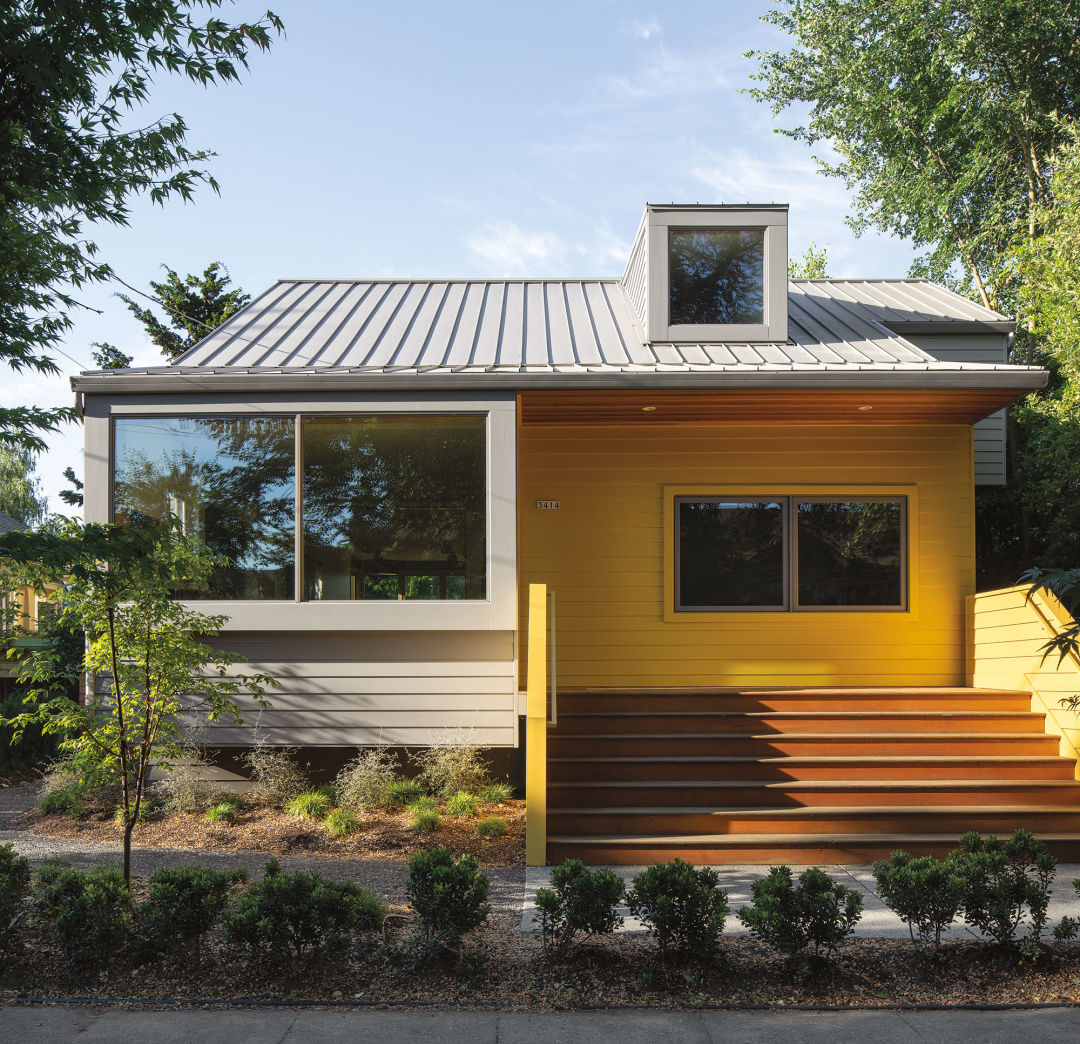
Image: Courtesy Jeremy Bittermann
Operation Sunlight
California transplants find sun & connection in a Northwest bungalow.
When you’ve just returned from several months working in Malawi in eastern Africa, an overcast Southeast Portland summer day can seem downright magical. At least that was the case for Amy Benson and Nick Brown—who didn’t miss the sweltering sunshine, but still wanted just enough natural light filling their home.
“There are no electric lights on in this house, even now,” Benson says on a cloudy morning from the kitchen of her family’s renovated bungalow. “That was the goal. It was really dark, and now it’s not.”
The couple, both doctors, met in the Peace Corps and spent the past several years splitting time between Portland and some of the poorest countries in Africa and South America, where Benson worked with pediatric AIDS cases and Brown as an adolescent psychiatrist. Ten years ago, they purchased a 2,600-square-foot bungalow in Southeast Portland that dates to 1914. They loved the house, but as California transplants they craved more outdoor light.
“They called it ‘Operation Sunlight,’” recalls architect Heidi Beebe of local firm Beebe Skidmore, which worked with the couple on the renovation. Benson and Brown wanted not just light, however, but better flow, so the couple could spend time with teenage sons Eli and Oliver without so many walls in between. And having grown up in a home designed by iconic architect Frank Gehry—known for buildings that twist and puncture 3-D space—Benson was unafraid to knock down some walls.
Viewed from outside, the house is unmistakable because of a new, square-shaped window protruding from the second floor. It’s an unapologetically contemporary addition to the otherwise historic early-20th-century architecture. But the oversize window brings light to both the living room and the upstairs hallway, where Beebe Skidmore cut a balcony-like opening. And the floor-to-ceiling glass of a small upstairs library acts as a kind of skylight for the downstairs kitchen.
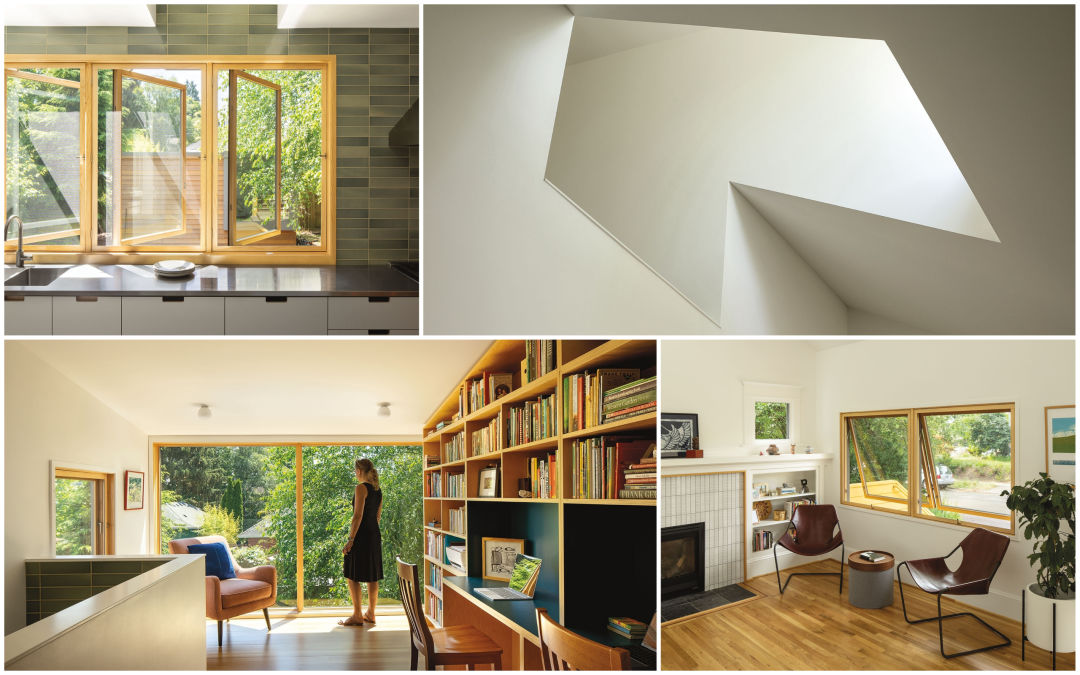
Architects Heidi Beebe and Doug Skidmore specialize in creative use of skylights, such as this one that illuminates both the living room and upstairs hallway. The second-floor library looks down through a wall of glass to the backyard and Brown’s detached office, as well as over a half-wall into the kitchen below.
Image: Courtesy Jeremy Bittermann
“Spreading light became a Trojan horse for another theme: how much they wanted their family to be able to connect,” architect Doug Skidmore explains. In its modern
iteration, it’s easy to call people downstairs to dinner without even raising your voice.
In the backyard, a small detached office cottage was also built for Nick, its large protruding window seeming to reach out toward the cantilevered upstairs portion of the house. Nowhere in this home—even in a different building—is the family disconnected from each other. “The flow of the house is much better,” Benson says. “But we still have distinct spaces where we can all be.”
With greenery visible from seemingly every window (even upstairs, thanks to a next-door neighbor’s green roof), this urban setting feels downright bucolic.
After one more year in Malawi, the couple will return to the now 3,350-square-foot house (including a new mudroom and a slightly expanded kitchen area) for good. “Any time you go to a different environment, you’re out of your comfort zone,” Brown says. “I think the house makes us feel more settled.”
